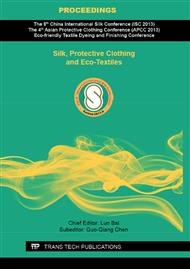p.601
p.607
p.613
p.617
p.623
p.630
p.634
p.639
p.643
Influence on Skin Burns by Water Absorbed Station Wear and Underwear in Firefighter Clothing
Abstract:
During firefighting, within firefighter clothing, underwear and station wear gets heavily wet due to firefighting water and moisture from the body. Water has higher thermal conductivity relative to air and it has been expected that heavily wet condition within the firefighter clothing makes faster skin burns. The objective of this study is how the wet condition within a firefighter clothing makes faster heat transfer from feeling pain and to being 2nd degree of skin burns relative to the dry condition in case of routine firefighting operation in a building (up to 20 kW/m2). Aramid station wear and cotton underwear, generally used by a Japanese firefighter, have been selected and cut 0.15 m x 0.15 m to attach an ISO 9151 copper sensor. A cone shape electric heater, which produces 12 kW/m2 to 20 kW/m2, was used to heat the fabrics. Scenario of fabrics are that (1) wet station wear and dry underwear, (2) wet station and wet underwear, (3) dry station wear and wet underwear, and (4) dry station wear and dry underwear. Evaluation method was by a heat transfer index (HTI) by ISO 9151. The time to rise temperature of 12 and 24 °C (HTI12 and HTI24), and heat transfer rate (dT/dt) were investigated for above four scenarios. The result shows that there was significant impact by condition of station wear, but little impact by underwear. In heat transfer rate (dT/dt) analysis, for the situation of feeling pain to the 2nd degree of skin burns (from HTI12 to HTI24), heat transfer rate was about 50% higher relative to the dry station wear condition. This result indicates that it is possible to be 2nd degree of skin burns easily as soon as a firefighter feels the pain, if he/she wears wet station wear.
Info:
Periodical:
Pages:
623-629
Citation:
Online since:
September 2013
Authors:
Price:
Сopyright:
© 2013 Trans Tech Publications Ltd. All Rights Reserved
Share:
Citation:


